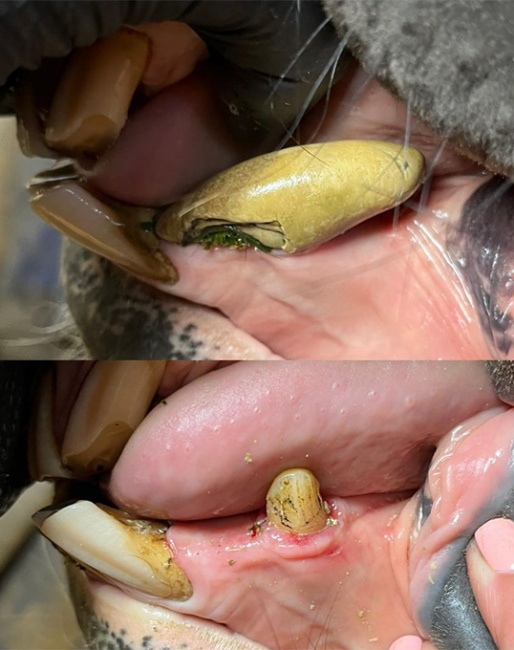
-- by Vikki Fowler, veterinary equine dentist
This is one of my favourite things to do. It’s super easy, and super quick but makes a massive difference.
This is plaque build up on a horse's canine. The plaque is mineral deposits that build up over time and it is not removed as these teeth are not used to eat. It has been proposed that the build up is due to saliva running over the lower canines and depositing minerals. Normally eating provides mechanical cleaning of the teeth with the horses dietary roughage but canines are fighting teeth, not eating teeth.
It is my personal experience that these build ups are predominantly (although not exclusively) in horses given natural water rather than mains water. Bore holes, springs, streams or rain water appear to have larger amounts of the minerals. This is only based on my own observations however.
Left in situ, this plaque build up causes localised gingivitis and can lead to gum recession. When it becomes as large as this one, it pushes into the tongue and can affect the bit placement too.
Interesting facts
- Usually only male horses have canines.
- Although in some rare cases we can see tiny ones in mares too. These mares have a historic reputation for being difficult to deal with.
- Canines and wolf teeth are not the same thing. Wolf teeth are further back, closer to the molars.
- Canines are like ice bergs, what you see on the surface is only a fraction of their full size.
- When the bit is in the correct position, the canines do not affect the bit. Make sure your bit isn’t too low and touching the canines.
- Rough handling of the bit when being put in and taken out can chip the canine teeth and cause pain. Often resulting in the horse showing avoidance behaviour during bitting or unbridling. Always take care that the bit doesn’t hook over the canines upon removal, especially if the horse throws its head up.
- The canines don’t have baby teeth predecessors. This means they must cut through the gum to erupt, this can be very uncomfortable and can also result in avoidance behaviour when bitting.
- The canines erupt between 5-5.5 year of age although they don’t often stick to the textbooks. Be understanding if your horse suddenly becomes a little bridle shy around this time. A bit of bongela over the erupting teeth can help.
-- by Vikki Fowler, veterinary equine dentist
Related Links
Boots and Bandages - Are we harming our horses as we try to protect them?
Noseband and Poll Pressures Underneath Bitless Bridles Measured
From the Horse’s Mouth... Actually the Horse’s Tongue
Why do Horses Need their Teeth Tending To? What about Those in the Wild?
A Bit is Only as Harsh as the Hands that Hold It
Some Thoughts on Crib Biting and How the Horse Owner Can Help